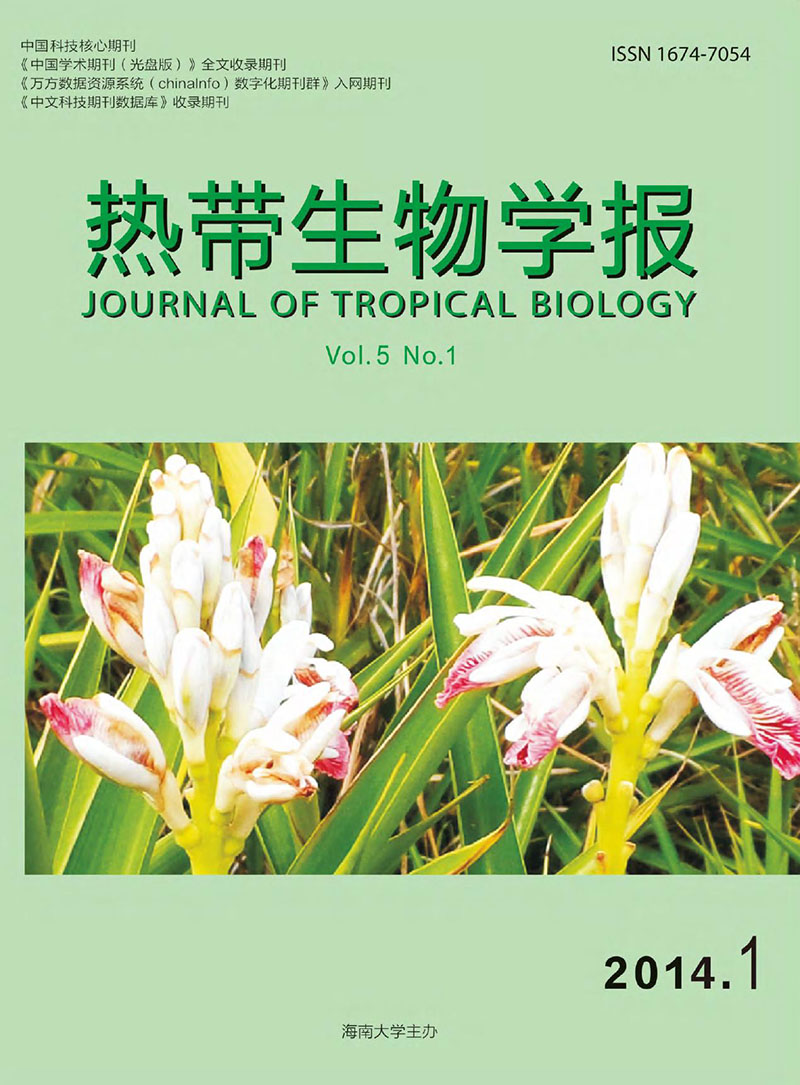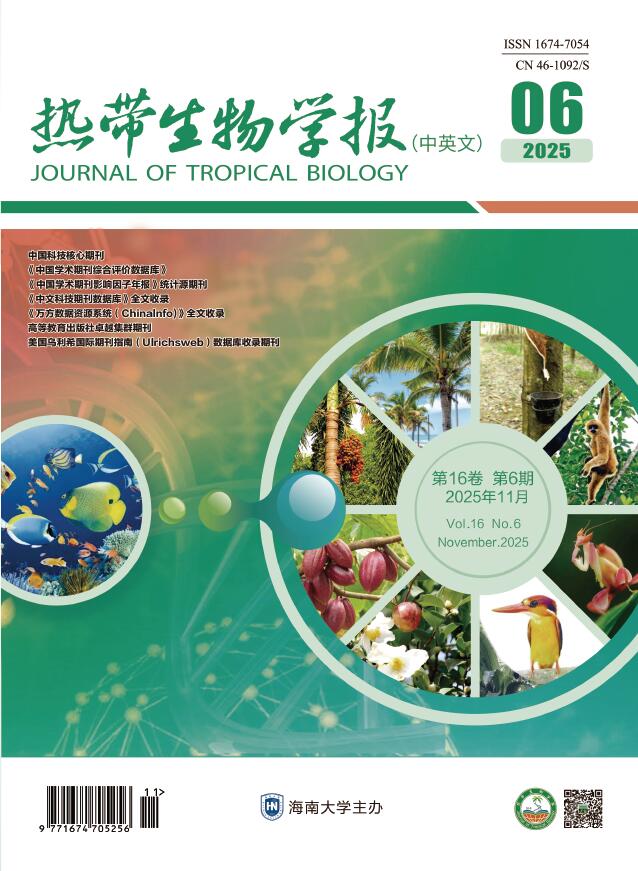2014 Vol. 5, No. 1
2014, 5(1): 1-7.
doi: 10.15886/j.cnki.rdswxb.2014.01.012
Abstract:
A total of 45 individuals from six species of pearl oysters( Pinctada spp.) were sequenced based on gene 16S and gene H3. NJ trees were constructed by the 45 tested oysters and the individuals from the GenBank database using 16S and H3 sequences. Most of the 45 tested oysters were clustered with the identical species from the GenBank database. With the help of simple and clear shell features,6 species of Pinctada collected from Hainan Province were identified. This classification method could not only help identify quickly and precisely species of Pinctada,and avoid influences of environmental and human factors,but also could facilitate crossbreeding and discovery of cryptic species of Pinctada.
A total of 45 individuals from six species of pearl oysters( Pinctada spp.) were sequenced based on gene 16S and gene H3. NJ trees were constructed by the 45 tested oysters and the individuals from the GenBank database using 16S and H3 sequences. Most of the 45 tested oysters were clustered with the identical species from the GenBank database. With the help of simple and clear shell features,6 species of Pinctada collected from Hainan Province were identified. This classification method could not only help identify quickly and precisely species of Pinctada,and avoid influences of environmental and human factors,but also could facilitate crossbreeding and discovery of cryptic species of Pinctada.
2014, 5(1): 8-14.
doi: 10.15886/j.cnki.rdswxb.2014.01.013
Abstract:
At Donghai Island,Zhanjiang,Guangdong,China were isolated 217 strains of bacteria from the water in 6 shrimp hatcheries,and their antibiotic resistance and susceptibility to 12 antibiotic agents was determined by using the Kirby-Bauer disc diffusion method for susceptibility testing. The results showed significant differences in bacterial resistance of the water to the 12 antibiotics( ANOVA,P < 0. 05). Bacteria of the water in the 6 hatcheries showed high susceptibility to polymyxin-B,levofloxacin,and ciprofloxacin and gave high resistance to ampicillin,trimethoprim,compound sinomi and tetracycline. Bacterial strains with multiple antibiotic resistances( MAR) were found in the water from each hatchery,and about 52. 07% of strains exhibited MAR,but none of the strains showed resistance to all 12 antibiotics. Statistical analysis indicated that no significant difference in antibiotic resistance of bacteria was observed in the water among the 6 hatcheries( ANOVA,P = 0. 273 > 0. 05) although antibiotic resistance of bacteria isolated from the water were higher in the hatcheries HM and XR than in the other hatcheries.
At Donghai Island,Zhanjiang,Guangdong,China were isolated 217 strains of bacteria from the water in 6 shrimp hatcheries,and their antibiotic resistance and susceptibility to 12 antibiotic agents was determined by using the Kirby-Bauer disc diffusion method for susceptibility testing. The results showed significant differences in bacterial resistance of the water to the 12 antibiotics( ANOVA,P < 0. 05). Bacteria of the water in the 6 hatcheries showed high susceptibility to polymyxin-B,levofloxacin,and ciprofloxacin and gave high resistance to ampicillin,trimethoprim,compound sinomi and tetracycline. Bacterial strains with multiple antibiotic resistances( MAR) were found in the water from each hatchery,and about 52. 07% of strains exhibited MAR,but none of the strains showed resistance to all 12 antibiotics. Statistical analysis indicated that no significant difference in antibiotic resistance of bacteria was observed in the water among the 6 hatcheries( ANOVA,P = 0. 273 > 0. 05) although antibiotic resistance of bacteria isolated from the water were higher in the hatcheries HM and XR than in the other hatcheries.
2014, 5(1): 15-19.
doi: 10.15886/j.cnki.rdswxb.2014.01.014
Abstract:
A unused abalone aquaculture pond was used for experiment in industrial aquaculture of Plectropomus leopardus. The aquaculture pond was spaced 9 m long,3 m wide and 2 m high with an effective depth of about 1. 7m,and had 3 water inlets. The water was discharged from the bottom of the pond and spilled over from the top. In the pond 6 perforated intake tubes were arranged 20 cm above the bottom to increase oxygen,and a 6. 0 m×3. 0 m×1. 5 m cage was placed in the pond to farm Plectropomus leopardus with the effective water depth of 1. 2m. The water used for the shrimp aquaculture was treated in a way as follows: the coastal sand filter well→ settling basin → triple filtration pool → ultraviolet disinfection pool → activated corallite filtering → aquaculture pond. The waste water spilled over from the top of the pond was used to farm Babylonia or bivalves. The aquaculture wastewater was discharged from the bottom of the pond into the settlement tank. In July 2011 9 000 quality fingerlings 10 cm long of P. leopardus was farmed in the cage,and 5 710 kg fishes with an average weight of about 742 g·fish were harvested in September 2012 after more than 15 months of aquaculture. The aquaculture survival rate was 85. 5%,and the yield was 12. 4 kg·m- 3.
A unused abalone aquaculture pond was used for experiment in industrial aquaculture of Plectropomus leopardus. The aquaculture pond was spaced 9 m long,3 m wide and 2 m high with an effective depth of about 1. 7m,and had 3 water inlets. The water was discharged from the bottom of the pond and spilled over from the top. In the pond 6 perforated intake tubes were arranged 20 cm above the bottom to increase oxygen,and a 6. 0 m×3. 0 m×1. 5 m cage was placed in the pond to farm Plectropomus leopardus with the effective water depth of 1. 2m. The water used for the shrimp aquaculture was treated in a way as follows: the coastal sand filter well→ settling basin → triple filtration pool → ultraviolet disinfection pool → activated corallite filtering → aquaculture pond. The waste water spilled over from the top of the pond was used to farm Babylonia or bivalves. The aquaculture wastewater was discharged from the bottom of the pond into the settlement tank. In July 2011 9 000 quality fingerlings 10 cm long of P. leopardus was farmed in the cage,and 5 710 kg fishes with an average weight of about 742 g·fish were harvested in September 2012 after more than 15 months of aquaculture. The aquaculture survival rate was 85. 5%,and the yield was 12. 4 kg·m- 3.
2014, 5(1): 20-24.
doi: 10.15886/j.cnki.rdswxb.2014.01.015
Abstract:
Heterotrophic dinoflagellate Oxyrrhis marina was grazed by Phaeocystis globosa to determine the lifecycle alternation in Phaeocystis globosa as response to chemical cues released from grazing O. marina. Colony formation in P. globosa was enhanced in terms of colony size when solitary cells of P. globosa were grazed by O. marina extensively. Even without direct physical contact with O. marina to initiate the defensive response,P. globosa received chemical signals generated during grazing activities that stimulated an increase in colony size. Colony enlargement belongs to inducible defense strategy,which allows P. globosa to defend against grazers. Life-cycle transformations and colony formation as responses to grazing may contribute to the global success of Phaeocystis.
Heterotrophic dinoflagellate Oxyrrhis marina was grazed by Phaeocystis globosa to determine the lifecycle alternation in Phaeocystis globosa as response to chemical cues released from grazing O. marina. Colony formation in P. globosa was enhanced in terms of colony size when solitary cells of P. globosa were grazed by O. marina extensively. Even without direct physical contact with O. marina to initiate the defensive response,P. globosa received chemical signals generated during grazing activities that stimulated an increase in colony size. Colony enlargement belongs to inducible defense strategy,which allows P. globosa to defend against grazers. Life-cycle transformations and colony formation as responses to grazing may contribute to the global success of Phaeocystis.
2014, 5(1): 25-29.
doi: 10.15886/j.cnki.rdswxb.2014.01.016
Abstract:
bcr /abl RNAi lentivirus vector was constructed and used to transfect K562 cells( the first human immortalised myelogenous leukemia line to be established),and the stable transfectants were selected. RNAi efficiency was assessed by Real-time PCR and Western blotting. The viability of the K562 cells was detected by CCK-8 assay and clonogenic assay. The results showed that bcr / abl RNAi significantly down regulates the amount of bcr / abl mRNA and P210bcr / abl fusion protein,and inhibits the proliferation of the K562 cells. The method of RNAi targeting bcr / abl fusion gene highlights a new way of chronic myelogenous leukemia treatment.
bcr /abl RNAi lentivirus vector was constructed and used to transfect K562 cells( the first human immortalised myelogenous leukemia line to be established),and the stable transfectants were selected. RNAi efficiency was assessed by Real-time PCR and Western blotting. The viability of the K562 cells was detected by CCK-8 assay and clonogenic assay. The results showed that bcr / abl RNAi significantly down regulates the amount of bcr / abl mRNA and P210bcr / abl fusion protein,and inhibits the proliferation of the K562 cells. The method of RNAi targeting bcr / abl fusion gene highlights a new way of chronic myelogenous leukemia treatment.
2014, 5(1): 30-35.
doi: 10.15886/j.cnki.rdswxb.2014.01.001
Abstract:
Arabidopsis non-host resistance gene( AtNHO1) encodes a putative glycerol kinase and plays an important role in plant PAMPs triggered immunity( PTI). The full length cDNA of rice( Oryza sativa) gene OsNHO1 was isolated by reverse transcription PCR,and the sequencing result showed that the open reading frame of OsNHO1 is 1 590 bp,encoding a 529 amino acids with a conserved NBD-sugar-kinase domain similar with NHO1 from Arabidopsis. Bioinformatics analysis showed that the amino acid sequence of the OsNHO1 is 99% similar with that of the NHO1 from Arabidopsis thaliana. Semi-quantitative RT-PCR analysis of the expression of OsNHO1 induced by SA and PXO999 showed that the OsNHO1 gene expression was induced by SA,PXO99,indicating that OsNHO1 is related to SA-mediated signaling transduction pathway and plays a key role in rice PAMPs triggered immunity( PTI).
Arabidopsis non-host resistance gene( AtNHO1) encodes a putative glycerol kinase and plays an important role in plant PAMPs triggered immunity( PTI). The full length cDNA of rice( Oryza sativa) gene OsNHO1 was isolated by reverse transcription PCR,and the sequencing result showed that the open reading frame of OsNHO1 is 1 590 bp,encoding a 529 amino acids with a conserved NBD-sugar-kinase domain similar with NHO1 from Arabidopsis. Bioinformatics analysis showed that the amino acid sequence of the OsNHO1 is 99% similar with that of the NHO1 from Arabidopsis thaliana. Semi-quantitative RT-PCR analysis of the expression of OsNHO1 induced by SA and PXO999 showed that the OsNHO1 gene expression was induced by SA,PXO99,indicating that OsNHO1 is related to SA-mediated signaling transduction pathway and plays a key role in rice PAMPs triggered immunity( PTI).
2014, 5(1): 36-42,47.
doi: 10.15886/j.cnki.rdswxb.2014.01.009
Abstract:
Stylosanthes guianensis is a perennial herb plant,and belongs to the genus Stylosanthes,the family Leguminous,and it is an excellent tropical pasture. Four Stylosanthes cultivars,tetraploids of Reyan No. 5,Reyan No. 2,Reyan No. 5,and Seca,were treated with salt in potting to observe their physiological and biochemical responses based on which a comprehensive assessment was made for their salt tolerance under salt stress. The results showed that the physiological and biochemical indexes of these cultivars were influenced by the salt concentration of 0. 90%,and that the growth indexes were influenced by the salt concentration of 1. 20%. Most seedlings were seriously influenced and died when treated with salt at the concentration of 1. 8%. Comprehensive analysis indicated that Seca showed the strongest salt tolerance,followed by the tetraploids of Reyan No. 5,and that Reyan No. 2 was the weakest in salt tolerance. All plants of the Stylosanthes cultivars grew well when treated with salt at the concentration of lower than 0. 90%,but hardly survived when treated with salt at the concentration of 1. 80%. Meanwhile,there were no obvious differences between tetraploid and diploid of Reyan No. 5.
Stylosanthes guianensis is a perennial herb plant,and belongs to the genus Stylosanthes,the family Leguminous,and it is an excellent tropical pasture. Four Stylosanthes cultivars,tetraploids of Reyan No. 5,Reyan No. 2,Reyan No. 5,and Seca,were treated with salt in potting to observe their physiological and biochemical responses based on which a comprehensive assessment was made for their salt tolerance under salt stress. The results showed that the physiological and biochemical indexes of these cultivars were influenced by the salt concentration of 0. 90%,and that the growth indexes were influenced by the salt concentration of 1. 20%. Most seedlings were seriously influenced and died when treated with salt at the concentration of 1. 8%. Comprehensive analysis indicated that Seca showed the strongest salt tolerance,followed by the tetraploids of Reyan No. 5,and that Reyan No. 2 was the weakest in salt tolerance. All plants of the Stylosanthes cultivars grew well when treated with salt at the concentration of lower than 0. 90%,but hardly survived when treated with salt at the concentration of 1. 80%. Meanwhile,there were no obvious differences between tetraploid and diploid of Reyan No. 5.
2014, 5(1): 43-47.
doi: 10.15886/j.cnki.rdswxb.2014.01.002
Abstract:
The structural features of gametophytes of Bolbitis angustipinna( Hayata) H. Ito at each stage of development were observed under the condition of artificial culture by using Olympus-BX53 optical microscope. The morphological characteristics of the border cell and the rhizoid differentiation were observed. It was found that the development of B. angustipinna gametophyte included spore germination,protonema development,formation of the prothallial plate,and prothallus formation. And the gametophyte of trichome,border cell and rhizoid had stable systematic characteristics: the trichome was unicellular and clavate; the border cell had two special forms,alveoli and protuberance; rhizoids were not only bended,bifurcated and top swollen but also constricted irregularly and serrated.
The structural features of gametophytes of Bolbitis angustipinna( Hayata) H. Ito at each stage of development were observed under the condition of artificial culture by using Olympus-BX53 optical microscope. The morphological characteristics of the border cell and the rhizoid differentiation were observed. It was found that the development of B. angustipinna gametophyte included spore germination,protonema development,formation of the prothallial plate,and prothallus formation. And the gametophyte of trichome,border cell and rhizoid had stable systematic characteristics: the trichome was unicellular and clavate; the border cell had two special forms,alveoli and protuberance; rhizoids were not only bended,bifurcated and top swollen but also constricted irregularly and serrated.
2014, 5(1): 48-51.
doi: 10.15886/j.cnki.rdswxb.2014.01.011
Abstract:
Angled luffa( Luffa acutangula L.) is a major vegetable gourd in South China. Two angled luffa varieties Haida 1 and 2 and the progenies of their reciprocal cross were planted in the garden to evaluate the inheritance of their major traits and their heterosis with a view to provide theoretical reference for heterosis breeding in angled luffa. The results showed that the first filial generation of the cross between Haida 1 and Haida 2 exhibited a genetic trait of heterosis. The F1 progenies grew more vigorous and slightly highly tolerant to diseases and their fruits sold well in the market. The F1 progeny of the direct cross between Haida 1 and 2 yielded 67 534. 5 kg·hm- 2,higher than its parents,and hence is very competitive in the market.
Angled luffa( Luffa acutangula L.) is a major vegetable gourd in South China. Two angled luffa varieties Haida 1 and 2 and the progenies of their reciprocal cross were planted in the garden to evaluate the inheritance of their major traits and their heterosis with a view to provide theoretical reference for heterosis breeding in angled luffa. The results showed that the first filial generation of the cross between Haida 1 and Haida 2 exhibited a genetic trait of heterosis. The F1 progenies grew more vigorous and slightly highly tolerant to diseases and their fruits sold well in the market. The F1 progeny of the direct cross between Haida 1 and 2 yielded 67 534. 5 kg·hm- 2,higher than its parents,and hence is very competitive in the market.
2014, 5(1): 52-56.
doi: 10.15886/j.cnki.rdswxb.2014.01.007
Abstract:
The soil under daily slurry flow( Treatment 1),seasonal slurry flow( Treatment 2) and control without slurry flow( Treatment 3) under the natural condition around the biogas factory was sampled to analyze soil bulk density,pH,organic matter,total P and total K. The results show that the soil in Treatments 1 and 2 with slurry flow was changed in soil quality. The soil organic matter and total N,total P and total K content were higher and the soil bulk density was lower in Treatments 1 and 2 than in the Treatment 3( the control). The soil pH changed little among the treatments. The treatments 1 and 2 had obviously higher organic content and total N and total K content but lower total P content than the lateritic soil in the paddy field,which indicates that long term flow of slurry resulted in soil nutrient imbalance due to excessive buildup of soil N and K and deficiency of P.
The soil under daily slurry flow( Treatment 1),seasonal slurry flow( Treatment 2) and control without slurry flow( Treatment 3) under the natural condition around the biogas factory was sampled to analyze soil bulk density,pH,organic matter,total P and total K. The results show that the soil in Treatments 1 and 2 with slurry flow was changed in soil quality. The soil organic matter and total N,total P and total K content were higher and the soil bulk density was lower in Treatments 1 and 2 than in the Treatment 3( the control). The soil pH changed little among the treatments. The treatments 1 and 2 had obviously higher organic content and total N and total K content but lower total P content than the lateritic soil in the paddy field,which indicates that long term flow of slurry resulted in soil nutrient imbalance due to excessive buildup of soil N and K and deficiency of P.
2014, 5(1): 57-61.
doi: 10.15886/j.cnki.rdswxb.2014.01.005
Abstract:
Composite films were prepared by using latex of natural rubber as the matrix and cross-linked porous starch as the reinforcing phase,and the structure and properties of the composite films were investigated. The results showed that the roughness of starch particle surface and specific surface area increased when porous starch was crosslinked. With the increase of cross-linked porous starch loading,the tensile strength and tear strength of the composite films increased first and then decreased. The composite film possesses the best mechanical properties at the cross-linked porous starch content of 10 parts per hundred rubber( phr). The glass transition temperature( Tg),thermal stability and solvent resistance of composite film are improved,but the water resistance is lower than that of the pure natural rubber latex film.
Composite films were prepared by using latex of natural rubber as the matrix and cross-linked porous starch as the reinforcing phase,and the structure and properties of the composite films were investigated. The results showed that the roughness of starch particle surface and specific surface area increased when porous starch was crosslinked. With the increase of cross-linked porous starch loading,the tensile strength and tear strength of the composite films increased first and then decreased. The composite film possesses the best mechanical properties at the cross-linked porous starch content of 10 parts per hundred rubber( phr). The glass transition temperature( Tg),thermal stability and solvent resistance of composite film are improved,but the water resistance is lower than that of the pure natural rubber latex film.
2014, 5(1): 62-66.
doi: 10.15886/j.cnki.rdswxb.2014.01.008
Abstract:
According to the pest risk assessment methods,the risk of introducing mango malformation disease into China was assessed based on geographical distribution,potential damage,economic impact,possibility of entry and establishment and difficulty of risk management. The overall risk value was 2. 3,which indicates that mango malformation is a highly dangerous pest in China. Some suggestions were also made for the control of this disease introduced into China.
According to the pest risk assessment methods,the risk of introducing mango malformation disease into China was assessed based on geographical distribution,potential damage,economic impact,possibility of entry and establishment and difficulty of risk management. The overall risk value was 2. 3,which indicates that mango malformation is a highly dangerous pest in China. Some suggestions were also made for the control of this disease introduced into China.
2014, 5(1): 67-72.
doi: 10.15886/j.cnki.rdswxb.2014.01.010
Abstract:
Cryo-sectioning,a fast and easy technique,is used to section delicate tissue and fleshy tissue and preserve cells within water-soluble and lipid-soluble inclusions and other features without dehydration and transparency,and has been widely used in animal and human studies,but seldom applied in plants. The roots,stems and leaves of cassava( Manihot esculenta Crantz.) were sectioned by using direct embedding cryosectioning,sucrose cryoprotectant cryosectioning and paraffin sectioning and observed and photographed under microscope. The results showed that the microstructures of the roots,stems and leaves of cassava sectioned by using the sucrose cryoprotectant cryosectioning were observed vivid to the true with better structural integrity and images of the sectioned tissues than those from the other two sectioning methods.
Cryo-sectioning,a fast and easy technique,is used to section delicate tissue and fleshy tissue and preserve cells within water-soluble and lipid-soluble inclusions and other features without dehydration and transparency,and has been widely used in animal and human studies,but seldom applied in plants. The roots,stems and leaves of cassava( Manihot esculenta Crantz.) were sectioned by using direct embedding cryosectioning,sucrose cryoprotectant cryosectioning and paraffin sectioning and observed and photographed under microscope. The results showed that the microstructures of the roots,stems and leaves of cassava sectioned by using the sucrose cryoprotectant cryosectioning were observed vivid to the true with better structural integrity and images of the sectioned tissues than those from the other two sectioning methods.
2014, 5(1): 73-77,91.
doi: 10.15886/j.cnki.rdswxb.2014.01.003
Abstract:
The protein extraction,isoelectric point of distribution and protein purification of the proteins of Gluconacetobacter,a stain produced bacterial cellulose,were tried and optimized to establish a set of two-dimensional polyacrylamide gel electrophoresis( 2DE) techniques for proteomic analysis of Gluconacetobacter. The results showed that Gluconacetobacter proteins were mainly distributed in the range of pI 4- 7. The 2D Clean-up kit purification after ultrafiltration concentration gave better protein separation effect. Under Coomassie brilliant blue G250 condition,( 1037 ±65) protein points were isolated.
The protein extraction,isoelectric point of distribution and protein purification of the proteins of Gluconacetobacter,a stain produced bacterial cellulose,were tried and optimized to establish a set of two-dimensional polyacrylamide gel electrophoresis( 2DE) techniques for proteomic analysis of Gluconacetobacter. The results showed that Gluconacetobacter proteins were mainly distributed in the range of pI 4- 7. The 2D Clean-up kit purification after ultrafiltration concentration gave better protein separation effect. Under Coomassie brilliant blue G250 condition,( 1037 ±65) protein points were isolated.
2014, 5(1): 78-83.
doi: 10.15886/j.cnki.rdswxb.2014.01.006
Abstract:
Model of cell injury induced by H2O2 was set up to evaluate the protective effect of the extracts derived from Alpinia officinarum Hance on PC12 cells injured by H2O2. Cell survival rate was detected by the MTT method,and the cell morphology was observed under fluorescence microscope. The leakage rate of lactate dehydrogenase( LDH),malonaldehyde( MDA) content,activities of superoxide dismutase( SOD) and glutathione peroxidase( GSH-Px) in PC12 cells were analyzed when PC12 cells were treated with the extracts from A. officinarum. The extracts obviously decreased the LDH leakage rate and the MDA content,but increased activities of SOD and GSH-Px in PC12 cells in a dose-dependent manner. It is thus inferred that the extracts of A. officinarum have an obviously protective effect on PC12 cells injured by H2O2. A neuroprotective medicine might be derived from these extracts which need further study.
Model of cell injury induced by H2O2 was set up to evaluate the protective effect of the extracts derived from Alpinia officinarum Hance on PC12 cells injured by H2O2. Cell survival rate was detected by the MTT method,and the cell morphology was observed under fluorescence microscope. The leakage rate of lactate dehydrogenase( LDH),malonaldehyde( MDA) content,activities of superoxide dismutase( SOD) and glutathione peroxidase( GSH-Px) in PC12 cells were analyzed when PC12 cells were treated with the extracts from A. officinarum. The extracts obviously decreased the LDH leakage rate and the MDA content,but increased activities of SOD and GSH-Px in PC12 cells in a dose-dependent manner. It is thus inferred that the extracts of A. officinarum have an obviously protective effect on PC12 cells injured by H2O2. A neuroprotective medicine might be derived from these extracts which need further study.
2014, 5(1): 84-91.
doi: 10.15886/j.cnki.rdswxb.2014.01.017
Abstract:
Volatile oil extracted from rhizome of Alpinia officinarum in Hainan was analyzed by using GC-MS fingerprinting,and 110 constituents from the volatile oil was determined,of which 20 constituents were detected accurate and stable with good repeatability. This fingerprinting method can be applied in the evaluation of A. officinarum as it is simple and reliable.
Volatile oil extracted from rhizome of Alpinia officinarum in Hainan was analyzed by using GC-MS fingerprinting,and 110 constituents from the volatile oil was determined,of which 20 constituents were detected accurate and stable with good repeatability. This fingerprinting method can be applied in the evaluation of A. officinarum as it is simple and reliable.
2014, 5(1): 92-100.
doi: 10.15886/j.cnki.rdswxb.2014.01.004
Abstract:
The research progresses on pathogenic mechanism of Fusarium oxysporum and plant resistance mechanism was reviewed,including signal transduction system,cell wall degrading enzymes( CWDEs),some enzymes involved in conquering plant defense system,and genes related to pathogenicity and metabolic pathway. Prospect of the mechanism of interaction between the pathogen and its host plant was discussed as well.
The research progresses on pathogenic mechanism of Fusarium oxysporum and plant resistance mechanism was reviewed,including signal transduction system,cell wall degrading enzymes( CWDEs),some enzymes involved in conquering plant defense system,and genes related to pathogenicity and metabolic pathway. Prospect of the mechanism of interaction between the pathogen and its host plant was discussed as well.



 Abstract
Abstract PDF 557KB
PDF 557KB



 Email alert
Email alert RSS
RSS